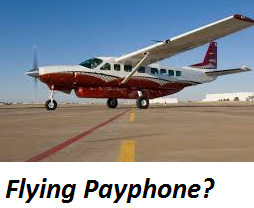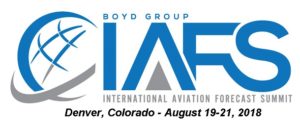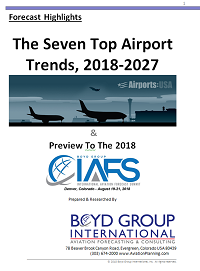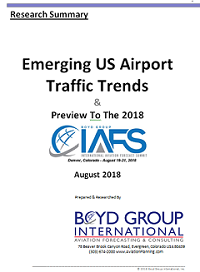Get “Future-Enabled” At The IAFS…
Trends, Data & Business Intelligence That Other Events Miss
We are excited that the International Aviation Forecast Summit is just two weeks away.
We thought it might be an idea to illuminate some of forecast trends we’ll be covering – most of which are galaxies ahead of any other industry event.
Airports:USA® Enplanement Forecast
The only projections accomplished entirely in the private sector, covering 146 airports that generate 95% of all US passenger traffic, the 2018-2027 Airports:USA® session will outline:
- Growth – over 5% this year, but with slowing rates below 2.5% for the next three years. The session will look at the underlying drivers
- High growth rates at regional, non-hubsite airports (under 2 million) but the growth will be geographic-specific
- Rapid spikes and declines as ULCC “wildcatter” airlines drill for net new traffic in places the major network carriers avoid
- Fuel costs will – will – result in major challenges to keeping rural regions connected to the global economy
- How long-haul route plans may be curtailed – for the near term – due to the cost of carrying fuel. A lot of planned new intercontinental markets from major airline hubsites will be dropped – affecting not just those airports, but air access in key regions of the US
- New carrier concepts – a candid look at new airline models, such as Moxy and low-frequency intra-regional business jet entities.
- The consumer-driven trend toward regionalization of access. A lot of ASD programs foisted on small communities to “lure” unnamed (and non-existent) airlines to the local airport will become increasingly obvious for what they are.
Fleet Forecasts – New Route Planning. New Facility Needs, Too
The major changes in the structure of the aircraft industry will be front and center at the IAFS™.
- The aircraft platforms coming on line are changing how carriers structure capacity, hub reach and competition.
- The new Boeing-Embraer and Airbus-Bombardier relationships and how that will affect airline fleet decisions
- The new 90-seat Bombardier Q-400 may have more impact in North America than some may think
- Plan on it: a 90-degree change at major carriers regarding 50-seat jets. Clear space in the desert – regardless of how things appear right now.
Fuel Projections
This year, Ben Brockwell of Oil Price Information Services will be back, and he has insights regarding fuel trends that will again threaten ambient thinking.
His analyses cover not just production, but the demand-drivers across the globe that will affect what airlines are paying in places like Omaha and Salt Lake City and Missoula.
Ben’s past forecasts at the IAFS™ have been spot-on. This year will likely be no different. It’s the reason we are always honored to have Ben at the event – consensus thinking has no role.
China Opportunity Forecasts – Getting “A Flight To China” Is Trendy. But Not Consistent With Reality
Boyd Group International is the leading source of research and consulting on the trends in China air service, and the burgeoning potential for access from there.
Unlike other consultants, we don’t just regurgitate government and other outside data. The China air market – domestic and internationally – is evolving rapidly and is focused on new dynamics that have no parallel here in the West. We pursue our own research and analysis of the trends and future of the China opportunity.
Our Airports:China program monitors changes in Chinese traffic, capacity, fleet trends and governmental policy shifts.
The data are nothing close to what some airports are trying to achieve. For example the vague concept of “a flight to China” – as if just tossing a plane toward old Cathay is the goal. Makes great press… but not a lot of sense.
China, where? What demand – now and ten years from now? What destination? What future expansion?
China is not some trophy destination, it is a giant country where the top 50 airports represent traffic opportunities that are tremendous, but balkanized. Most secondary, non-hubsite airports in the US don’t have anywhere enough demand to any one Chinese destination, regardless of the level of Chinese investment in the region. Even having one or two huge Chinese-owned businesses in the region is no guarantee of sufficient traffic to support nonstop service.
And without real connecting hub operations in China (yet), a flight from just about any Chinese destination is all dependent on local O&D. Delta’s recently-implemented ATL-PVG flights have lots of US connectivity. But at the China end, even with a code-share with China Eastern and its partners, connectivity within 4 hours is to only around 15 cities – if the already-full load factors on those flights allow. The point is that from the US, service from key connecting hubs will be a success.
But outside of major AA, DL and UA hubsites, the prospects at the moment are not good. But that will change, and that will take planning, and a major change of mindset at some communities.
Our Airports:China™ forecast session will deliver new perspectives on developing outreach to and service connectivity with the China market.
- New approaches – the high-level political junkets need to be replaced with targeted objectives. Chasing across China, meeting with officials, and making great press back home is increasingly eye-wash, not effective planning. It does not alter the structural challenges regarding China access
- Recognition of the Chinese air transportation system. Despite the lore – China has yet to develop US-style connecting hubs.
- The effects of higher fuel prices on delivering the advantage to Chinese airlines (Think trip origination trends.)
- The “Mianyang dynamic” – emerging growth in key commercial centers in China – changing air service systems
Point: air access with China is not some trendy trophy. There has to be demand, and there are pertinent challenges that need to be addressed, well beyond the hype and flashy dinners with Chinese airports.
These are just a few of the areas we’ll be covering August 19-21 in Denver. Our hosts, Denver International Airport, have pulled out all the stops to make this IAFS™ the most exciting yet.
Challenge The Status Quo…
Finally, as another factor that sets IAFS™ apart, there is a special reception on Saturday, 18 August being held by Boom Supersonic. Attendees of the IAFS™ are invited to see the future – the concept of a 2.2 Mach airliner that the “experts” said was a pipe dream.
Funny, but Japan Airlines, Virgin Atlantic, and China’s largest travel conglomerate, as well as a litany of high-level financial investors, don’t agree with the “experts.” Join us for the Summit and see the future.
Click here to register, and we will see you in Denver!
__________________________
Chicken Little Lives!
It’s broadcast lore.
In 1938, a radio show playing H. G. Well’s War of The Worlds, got taken for real, instead of the hoax it really was.
Narrated by Orson Welles, the special Halloween format was the weekly CBS variety show, Mercury Theater On the Air. On this evening, however, it was repeatedly interrupted by what sounded like real news bulletins about a Martian landing in rural New Jersey, and then how they were invading all across the country, terrifying the populace and wrecking the place with ray guns.
A lot of people didn’t hear the beginning of the show, and went bonkers in fear of little green men doing impromptu urban renewal with heat-ray weapons on towns all across America.
It was, obviously, taken out of context. More than a little.
It’s Not Space Creatures. Just The TSA. This week, we had a similar situation. Even though it came from the TSA, it, too, was a hoax – at least when considered calmly and professionally, which hasn’t been done much. Hysteria is so much more fun than facts.
CNN reported – and implied in a long detailed story that it was for real – that the TSA was planning to drop security at small airports. Planes smaller than 60 seats would just fly unscreened passengers, and those connecting to other flights would go through security at the larger, arrival airport.
The story recounted at length how some internal TSA document claimed it would save money and would not reduce security. CNN postured the suggestion as being a serious threat to America.
Alas, within the context of aviation realities, it’s the same level of threat as was recounted that night 80 years ago by Orson Welles.
On Cue: Let The Crocodile Outrage Begin. Yikes! The sheer crust of the administration – yup, they had to work that part in – was another indication that money was more important than keeping the skies safe.
Lots of uproar. Lots of panting media indignation. Some industry groups almost jumped in their water dishes, they were so righteously enraged upon hearing the CNN story. Other media picked it up, with headlines often stating that the TSA was actually planning to move ahead and close down screening at small airports.
Oh, no! Thousands of passengers would not be screened! Now, there would be an open channel for terrorists to hop on planes in Muskegon, Yuma, Cortez and Jamestown, free to have their way with us.
In The Light of Hard Reality, Not Only Dumb, But Clearly Impossible. Here’s a clue… like War of The Worlds, the whole thing was something that in reality couldn’t happen. That’s because the TSA suggestion cannot be accomplished. It’s impossible to implement.
Read: as impossible as a Martian space ship landing at JFK – pre-screened or not.
If anybody had given the concept as much as five minutes of consideration, it would be clear that this was at best a dimbulb idea generated in one of those trendy but waste-of-time brainstorming sessions that entities like the TSA engage in from time to time.
Say it again… regardless of the veneer hype, the proposal that CNN passed off as so real would be impossible – impossible – to implement. Nobody bothered to even give it a second look for functional credibility.
But this one – to eliminate security screening at small airports – is even more in la-la land than the possibility of little green creatures with one big eye and a ray gun showing up at the door, asking directions back to the Red Planet.
Security Concerns: Even Suggesting This Shows How Incompetent TSA Management Is. First, critics are 100% right – dropping screening as was outlined is world-class dumb, even if it were just a suggestion at some mentally-moribund planning process at the TSA.
Media: You’ve Just Joined The Orson Welles Fan Club. We need to candidly question not only the TSA leadership, but the levels of professional scrutiny some of the media gave to the story before they blasted it across the wires.
The point is that anybody with a modicum of knowledge of airports, and who is awake, sober and holds an IQ just slightly higher than that of an artichoke, would know immediately that the concept simply can’t be implemented.
Indeed, out of the box, the concept is DOA. One word: facilities.
Think about the hubsite logistics. At some of these airports, the concept of accepting non-sterile arriving passengers represents a logistical nightmare not seen since Napoleon was trying to get the Grand Armee back from Russia.
First, to segregate non-screened passengers on arrival would mean enormous re-structuring of gate and concourse facilities at hubsite airports. And not a little, either.
Contrary to what the supposed TSA suggestion implied, and which media babble assumed, it isn’t a simple process to keep separate arriving non-sterile local passengers from ones who are connecting to other flights at the hubsite airport.
In Lieu of A Screening Point At Gainesville, Let’s Reconfigure Entire Airports. First, think about the wayfinding necessary to separate these two categories of non-sterile passengers. Then, consider the channels to get the connecting passengers to some screening point – which at most big airports is nowhere near the gate facilities. Then have the channels to keep the destination passengers out of any sterile area while they head to the baggage claim and curbside.
Now, think about a hubsite airport… how ‘bout Detroit Metro. Think about getting these non-sterile passengers arriving on concourse C through the terminal. Think about how and where whole new screening points need to be set up.
Think about the resulting inefficient use of gates, as some may need to be “de-sterilized” for passengers arriving from non-screened airports.
Oh yeah. Think about the need to materially increase minimum connecting time at every airline connecting hub airport, in order to screen the folks coming in from Alpena to connect to Tucson. That 35-minute connection is a thing of the past. Think more like 60 to 75 minutes. Airline scheduling will be completely changed.
Think about how this concept would literally flummox the entire US air transportation system.
And think about the fact that it would be impossible to re-configure connecting hub airports to make this work.
Think… And Report Informatively. This is the point. Yes, for the TSA to even consider this to the point that they spent the time to put a price tag on it, shows that the great traditions of dimbulb thinking, begun with the early TSA pioneers in non-security, continue on.
But what is astounding is that just about every “expert” that the media contacted regarding this idiotic concept, never even bothered to consider the fact that, just like a landing from Mars, the whole thing is outside the realm of being physically implemented.
No Big Deal. We’ve Already Accepted The Equivalent of Non-Screening. Final point. Three years ago, we functionally had exactly the same situation as the one represented by not screening at small airports. We had a 96% failure rate in testing of screening across the US. Effectively, our airports were (and may still be) a terrorist sieve.
Can’t remember the same media outrage over that.
Or the feigned outrage from some of those alphabet groups inside the Beltway that are today in a froth over the equivalent of an extra-terrestrial invasion.
Move along, folks. Nothing happening here.
 It’s the same with air access. Just because there’s no scheduled service at a given small community airport does not mean that the consumers are stuck trying to get into or out of town. As with the communication channel represented by the pay phone, they’ve switched to other modes.
It’s the same with air access. Just because there’s no scheduled service at a given small community airport does not mean that the consumers are stuck trying to get into or out of town. As with the communication channel represented by the pay phone, they’ve switched to other modes. Recently, we saw a small, un-served airport, whose downtown is less than a 60 minute drive from over 600 daily nonstop flights, claim it will pony up nearly a quarter million dollars in consultant fees and incentives to get scheduled flights at the local airport.
Recently, we saw a small, un-served airport, whose downtown is less than a 60 minute drive from over 600 daily nonstop flights, claim it will pony up nearly a quarter million dollars in consultant fees and incentives to get scheduled flights at the local airport. But the China opportunity is one for the future, and after World Routes give us a call. We can assist airports of all roles and sizes develop effective outreach to capture more business and Chinese investment for their regions of the country.
But the China opportunity is one for the future, and after World Routes give us a call. We can assist airports of all roles and sizes develop effective outreach to capture more business and Chinese investment for their regions of the country. Do a search – you’ll find that the content of the Summit has driven a lot of in-depth media stories.
Do a search – you’ll find that the content of the Summit has driven a lot of in-depth media stories.
